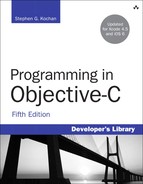Book Description
Programming in Objective-C, Fifth Edition
Updated for OS X Mountain Lion, iOS 6, and Xcode 4.5
Programming in Objective-C is a concise, carefully written tutorial on the basics of Objective-C and object-oriented programming for Apple's iOS and OS X platforms.
The book makes no assumptions about prior experience with object-oriented programming languages or with the C language (which Objective-C is based upon). Because of this, both beginners and experienced programmers alike can use this book to quickly and effectively learn the fundamentals of Objective-C. Readers can also learn the concepts of object-oriented programming without having to first learn all of the intricacies of the underlying C programming language.
This unique approach to learning, combined with many small program examples and exercises at the end of each chapter, makes Programming in Objective-C ideally suited for either classroom use or self-study.
This edition has been fully updated to incorporate new features in Objective-C programming introduced with Xcode 4.4 (OS X Mountain Lion) and Xcode 4.5 (iOS 6.)
“The best book on any programming language that I’ve ever read. If you want to learn Objective-C, buy it.”–Calvin Wolcott
“An excellent resource for a new programmer who wants to learn Objective-C as their first programming language–a woefully underserved market.”–Pat Hughes
Contents at a Glance
1 Introduction
Part I The Objective-C Language
2 Programming in Objective-C
3 Classes, Objects, and Methods
4 Data Types and Expressions
5 Program Looping
6 Making Decisions
7 More on Classes
8 Inheritance
9 Polymorphism, Dynamic Typing, and Dynamic Binding
10 More on Variables and Data Types
11 Categories and Protocols
12 The Preprocessor
13 Underlying C Language Features
Part II The Foundation Framework
14 Introduction to the Foundation Framework
15 Numbers, Strings, and Collections
16 Working with Files
17 Memory Management and Automatic Reference Counting (ARC)
18 Copying Objects
19 Archiving
Part III Cocoa, Cocoa Touch, and the iOS SDK
20 Introduction to Cocoa and Cocoa Touch
21 Writing iOS Applications
Appendixes
A Glossary
B Address Book Program Source Code
Table of Contents
- Title Page
- Copyright Page
- Dedication Page
- Contents at a Glance
- Table of Contents
- Developer’s Library
- About the Author
- About the Technical Reviewers
- We Want to Hear from You!
- Reader Services
- 1. Introduction
- Part I: The Objective-C Language
- 2. Programming in Objective-C
- 3. Classes, Objects, and Methods
- 4. Data Types and Expressions
- 5. Program Looping
- 6. Making Decisions
- 7. More on Classes
- 8. Inheritance
- 9. Polymorphism, Dynamic Typing, and Dynamic Binding
- 10. More on Variables and Data Types
- 11. Categories and Protocols
- 12. The Preprocessor
- 13. Underlying C Language Features
- Part II: The Foundation Framework
- Part III: Cocoa, Cocoa Touch, and the iOS SDK
- Appendixes
- Index
- Ad Page
